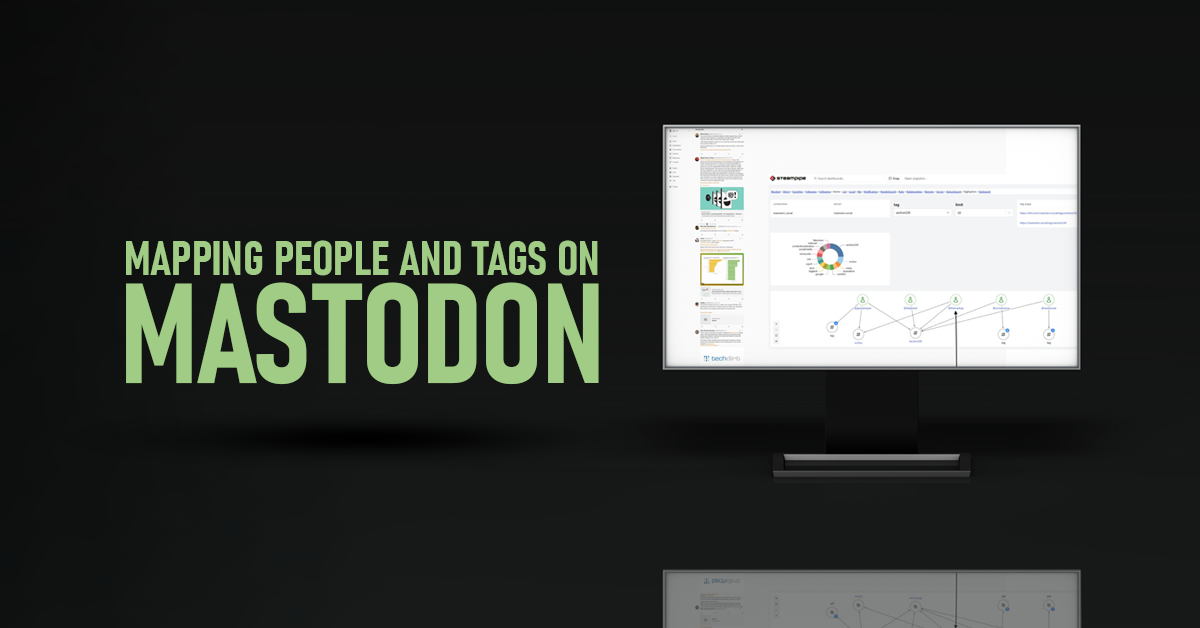Mapping people and tags on Mastodon

Data Scientist
Deep learning and machine learning specialist, well-versed with experience in Cloud infrastructure, Block-chain technologies, and Big Data solutions.
May 08, 2023

Understanding Mastodon
There are several separate servers arranged according to topics, interests, and topics of interest in Mastodon, a decentralized social network. People can participate in conversations, follow one another, join servers, and perform a variety of other actions they might anticipate performing on a social network like Twitter. Mastodon was created in March 2016, but it took off when someone purchased a particular social media platform in late 2022. This is mainly due to the large number of Twitter users who announced they would be switching to Mastodon. While the tweets you've seen recently about Mastodon might give the impression that it's just a knockoff, Mastodon is actually entirely different from the blue bird app.
One word best describes the main distinction between Mastodon and Twitter: decentralization. Platforms for social media like Twitter are centralized, which means a single business owns and runs them. This company manages all social network aspects, including developing features, policing content, adjusting algorithms, and more. Contrarily, the social media platform Mastodon is decentralized within the non-profit organization Mastodon gGmbH, despite employees working there working on the platform. This is due to the fact that it is composed of thousands of separate servers.
A Mastodon server can be compared to a small social network or forum, and a server is typically structured around a particular interest, subject, or industry. Any user on Mastodon, regardless of which server they are on, can be followed, replied to, and engaged with once they have joined a server. Mastodon offers a wide range of features, but what exactly can you do with it? The quick response is that Twitter allows you to do many of the same things. You can post pictures of your cats, participate in conversations that appear in your feed, and discuss whatever is on your mind. Your feed, where you can see updates from the users you follow, and an explore tab, enabling you to discover new interesting people, are provided. On Twitter, you can create a thread, but on Mastodon, you can reply to yourself and create a similar one.
The most considerable servers are general, which means they don't focus on a particular subject; these will feel more like Twitter. However, you'll also discover that some of the most well-liked servers are related to tech subjects like Bitcoin and software development.
Using Mastodon as the social network of choice for campaigns you've run on Twitter so far might leave you disappointed. It is not possible for businesses to do marketing on Mastodon through a single individual or platform because it is a network of servers rather than a single social platform. Additionally, it is stated on Mastodon's homepage that the service will never display advertisements or favor specific profiles over others. A non-profit operates Mastodon, so there is no incentive to make money and no desire to partner with advertisers. However, there are still ways for companies to profit from this increase in Mastodon's interest.
It's possible to use Mastodon as an alternative to Twitter when it comes to advertising in the social media space. This is because even though Twitter allows you to search by hashtags and topics, the algorithm still presents you with an unorganized jumble of Tweets in a disorganized order. With Mastodon, however, each server is essentially a self-contained community built around a single theme, be it location, a common interest, or even a particular profession. If you can locate the correct server, you can gain direct access to the issues that are important to your target market or a new market niche.
Mastodon is a perfect platform for running affiliate marketing, sponsorship, and user-generated content campaigns. Similar to how you would go on another platform, you could try contacting specific accounts with a certain number of followers; you might need to do a little more searching to find the proper accounts. Mastodon generally has fewer followers than Twitter, so your efforts might not be as successful.
Unlike many social networks, Mastodon's creators are adamantly anti-advertising. For this reason, there is no system in place for dispersing advertising across many servers. Although each server runs independently, nothing prevents a server owner from installing their own payment processing system, which technically allows servers to sell advertising space.
However, you may encounter some opposition if you post advertisements on Mastodon. Users of Mastodon anticipate seeing fewer, if any, advertisements.
Although you might not be able to run advertisements or discover the next big influencer on Mastodon, do you know what you can do there? Control your own server.
Even though running your own Mastodon server has one significant advantage over creating a YouTube channel or a Twitter account, it is a little more technically challenging. You have complete command over it, and this implies that you have the option to decide whether to approve each new account, manage content moderation, and control the conversation. Due to its effectiveness, it may be a good marketing tool. You can't just post and hope for the best on Mastodon because there isn't an algorithm that favors some posts over others. Make a concerted effort to interact with the community if you want to gain traction. However, because Mastodon is structured around servers, you can easily find your customers, both current and potential, without having to trawl through the void.
Mastodon relationship graphs
Mastodon relationship graphs show that Steampipe is capable of mapping Mastodon network neighborhoods. This graph tool can help DevOps and security professionals see the resources associated with an EC2 instance or easily determine whether permissions assigned to IAM roles are appropriately scoped thanks to context-aware graphs. Developers can, as always, examine and remix the code that generates these graphs and modify the idioms to suit their own needs in any data domain.
SQL queries define these relationship graphs' nodes and edges. A Steampipe plugin can provide any column from any table that can be used to simulate nodes and edges between nodes. Now, you can use SQL idioms to graph the relationships between the people and things that are represented by various APIs, and your imagination is the only restriction. These neighborhood maps have selected the boost, which is a retweet on Mastodon. A particular instance that appears in the home timeline is the subject of one of the maps. It displays users who are part of that instance and who have received boosts from users on related or unrelated instances.
The other map enlarges to reveal relationships between every instance that appears in the timeline for the home. This view concentrates on server-to-server relationships and would not be readable if it included people. These maps are a collection of toots. To focus on fostering relationships, they omit original toots to which no one replies as well as replies. How about retorts? That would be a unique map that is also fun to create.
The hashtags are followed on Mastodon when you are logged in. As a result, updates with a specific tag will start to show up alongside updates from your followers in your timeline.
For instance, if you follow the hashtag #Gardening, posts about gardening from users you need to follow will start to show up in your timeline. This makes finding new people to follow through hashtag searching incredibly useful.
On Mastodon, you can follow hashtags by doing the following:
1. Sign up using the website for your server or a hashtag-following app.
2. Find the hashtag you would like to follow, then click it to see the search results associated with the hashtag.
3. Listed in the top right corner of the hashtag results page, you can follow a hashtag by clicking its + icon or Follow button. If you wish to stop following it, you need to click the same icon a second time.
4. Now, even updates from users you aren't following will appear in your home timeline if they use that tag. On the website and in the apps, they will be viewable in the home timeline.
Conclusion
Before Musk took control, there were reports that Twitter usage was declining. Not the number of accounts but human usage is that count. The number of monthly active users and the total number of instances are the best indicators of Mastodon's growth. People join communities called instances, and Mastodon is the collective name for those instances. It is a component of the Fediverse, a network of open-source systems. You can navigate all of the Mastodon instances simultaneously when they are linked together to form a single system. However, since they run independently, instances may lose connection with one another. For instance, a gateway to hate speech could be isolated from other instances people have joined to affect how they perceive Mastodon. The help page for Mastodon states that additional blocking techniques are being developed. That's obviously urgent..













